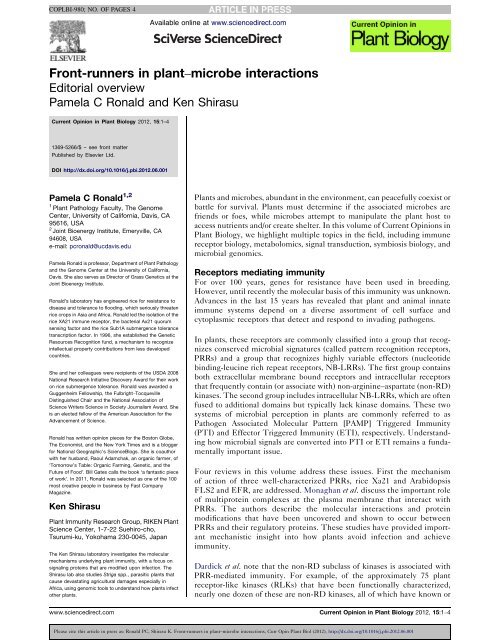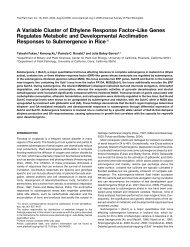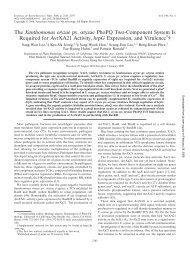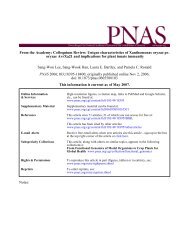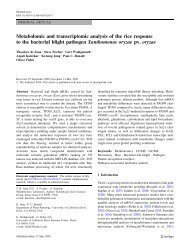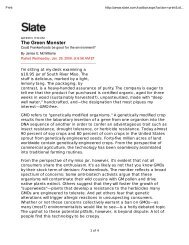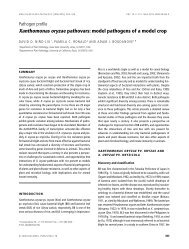Front-runners in plant–microbe interactions - Pamela Ronald
Front-runners in plant–microbe interactions - Pamela Ronald
Front-runners in plant–microbe interactions - Pamela Ronald
- No tags were found...
Create successful ePaper yourself
Turn your PDF publications into a flip-book with our unique Google optimized e-Paper software.
COPLBI-980; NO. OF PAGES 4<br />
Available onl<strong>in</strong>e at www.sciencedirect.com<br />
<strong>Front</strong>-<strong>runners</strong> <strong>in</strong> <strong>plant–microbe</strong> <strong>in</strong>teractions<br />
Editorial overview<br />
<strong>Pamela</strong> C <strong>Ronald</strong> and Ken Shirasu<br />
Current Op<strong>in</strong>ion <strong>in</strong> Plant Biology 2012, 15:1–4<br />
1369-5266/$ – see front matter<br />
Published by Elsevier Ltd.<br />
DOI http://dx.doi.org/10.1016/j.pbi.2012.06.001<br />
<strong>Pamela</strong> C <strong>Ronald</strong> 1,2<br />
1 Plant Pathology Faculty, The Genome<br />
Center, University of California, Davis, CA<br />
95616, USA<br />
2 Jo<strong>in</strong>t Bioenergy Institute, Emeryville, CA<br />
94608, USA<br />
e-mail: pcronald@ucdavis.edu<br />
<strong>Pamela</strong> <strong>Ronald</strong> is professor, Department of Plant Pathology<br />
and the Genome Center at the University of California,<br />
Davis. She also serves as Director of Grass Genetics at the<br />
Jo<strong>in</strong>t Bioenergy Institute.<br />
<strong>Ronald</strong>’s laboratory has eng<strong>in</strong>eered rice for resistance to<br />
disease and tolerance to flood<strong>in</strong>g, which seriously threaten<br />
rice crops <strong>in</strong> Asia and Africa. <strong>Ronald</strong> led the isolation of the<br />
rice XA21 immune receptor, the bacterial Ax21 quorum<br />
sens<strong>in</strong>g factor and the rice Sub1A submergence tolerance<br />
transcription factor. In 1996, she established the Genetic<br />
Resources Recognition fund, a mechanism to recognize<br />
<strong>in</strong>tellectual property contributions from less developed<br />
countries.<br />
She and her colleagues were recipients of the USDA 2008<br />
National Research Initiative Discovery Award for their work<br />
on rice submergence tolerance. <strong>Ronald</strong> was awarded a<br />
Guggenheim Fellowship, the Fulbright–Tocqueville<br />
Dist<strong>in</strong>guished Chair and the National Association of<br />
Science Writers Science <strong>in</strong> Society Journalism Award. She<br />
is an elected fellow of the American Association for the<br />
Advancement of Science.<br />
<strong>Ronald</strong> has written op<strong>in</strong>ion pieces for the Boston Globe,<br />
The Economist, and the New York Times and is a blogger<br />
for National Geographic’s ScienceBlogs. She is coauthor<br />
with her husband, Raoul Adamchak, an organic farmer, of<br />
‘Tomorrow’s Table: Organic Farm<strong>in</strong>g, Genetic, and the<br />
Future of Food’. Bill Gates calls the book ‘a fantastic piece<br />
of work’. In 2011, <strong>Ronald</strong> was selected as one of the 100<br />
most creative people <strong>in</strong> bus<strong>in</strong>ess by Fast Company<br />
Magaz<strong>in</strong>e.<br />
Ken Shirasu<br />
Plant Immunity Research Group, RIKEN Plant<br />
Science Center, 1-7-22 Suehiro-cho,<br />
Tsurumi-ku, Yokohama 230-0045, Japan<br />
The Ken Shirasu laboratory <strong>in</strong>vestigates the molecular<br />
mechanisms underly<strong>in</strong>g plant immunity, with a focus on<br />
signal<strong>in</strong>g prote<strong>in</strong>s that are modified upon <strong>in</strong>fection. The<br />
Shirasu lab also studies Striga spp., parasitic plants that<br />
cause devastat<strong>in</strong>g agricultural damages especially <strong>in</strong><br />
Africa, us<strong>in</strong>g genomic tools to understand how plants <strong>in</strong>fect<br />
other plants.<br />
Plants and microbes, abundant <strong>in</strong> the environment, can peacefully coexist or<br />
battle for survival. Plants must determ<strong>in</strong>e if the associated microbes are<br />
friends or foes, while microbes attempt to manipulate the plant host to<br />
access nutrients and/or create shelter. In this volume of Current Op<strong>in</strong>ions <strong>in</strong><br />
Plant Biology, we highlight multiple topics <strong>in</strong> the field, <strong>in</strong>clud<strong>in</strong>g immune<br />
receptor biology, metabolomics, signal transduction, symbiosis biology, and<br />
microbial genomics.<br />
Receptors mediat<strong>in</strong>g immunity<br />
For over 100 years, genes for resistance have been used <strong>in</strong> breed<strong>in</strong>g.<br />
However, until recently the molecular basis of this immunity was unknown.<br />
Advances <strong>in</strong> the last 15 years has revealed that plant and animal <strong>in</strong>nate<br />
immune systems depend on a diverse assortment of cell surface and<br />
cytoplasmic receptors that detect and respond to <strong>in</strong>vad<strong>in</strong>g pathogens.<br />
In plants, these receptors are commonly classified <strong>in</strong>to a group that recognizes<br />
conserved microbial signatures (called pattern recognition receptors,<br />
PRRs) and a group that recognizes highly variable effectors (nucleotide<br />
b<strong>in</strong>d<strong>in</strong>g-leuc<strong>in</strong>e rich repeat receptors, NB-LRRs). The first group conta<strong>in</strong>s<br />
both extracellular membrane bound receptors and <strong>in</strong>tracellular receptors<br />
that frequently conta<strong>in</strong> (or associate with) non-arg<strong>in</strong><strong>in</strong>e–aspartate (non-RD)<br />
k<strong>in</strong>ases. The second group <strong>in</strong>cludes <strong>in</strong>tracellular NB-LRRs, which are often<br />
fused to additional doma<strong>in</strong>s but typically lack k<strong>in</strong>ase doma<strong>in</strong>s. These two<br />
systems of microbial perception <strong>in</strong> plants are commonly referred to as<br />
Pathogen Associated Molecular Pattern [PAMP] Triggered Immunity<br />
(PTI) and Effector Triggered Immunity (ETI), respectively. Understand<strong>in</strong>g<br />
how microbial signals are converted <strong>in</strong>to PTI or ETI rema<strong>in</strong>s a fundamentally<br />
important issue.<br />
Four reviews <strong>in</strong> this volume address these issues. First the mechanism<br />
of action of three well-characterized PRRs, rice Xa21 and Arabidopsis<br />
FLS2 and EFR, are addressed. Monaghan et al. discuss the important role<br />
of multiprote<strong>in</strong> complexes at the plasma membrane that <strong>in</strong>teract with<br />
PRRs. The authors describe the molecular <strong>in</strong>teractions and prote<strong>in</strong><br />
modifications that have been uncovered and shown to occur between<br />
PRRs and their regulatory prote<strong>in</strong>s. These studies have provided important<br />
mechanistic <strong>in</strong>sight <strong>in</strong>to how plants avoid <strong>in</strong>fection and achieve<br />
immunity.<br />
Dardick et al. note that the non-RD subclass of k<strong>in</strong>ases is associated with<br />
PRR-mediated immunity. For example, of the approximately 75 plant<br />
receptor-like k<strong>in</strong>ases (RLKs) that have been functionally characterized,<br />
nearly one dozen of these are non-RD k<strong>in</strong>ases, all of which have known or<br />
www.sciencedirect.com Current Op<strong>in</strong>ion <strong>in</strong> Plant Biology 2012, 15:1–4<br />
Please cite this article <strong>in</strong> press as: <strong>Ronald</strong> PC, Shirasu K. <strong>Front</strong>-<strong>runners</strong> <strong>in</strong> <strong>plant–microbe</strong> <strong>in</strong>teractions, Curr Op<strong>in</strong> Plant Biol (2012), http://dx.doi.org/10.1016/j.pbi.2012.06.001
COPLBI-980; NO. OF PAGES 4<br />
2 Biotic <strong>in</strong>teractions<br />
putative functions <strong>in</strong> the recognition of conserved<br />
microbial signatures characteristic of PRRs. Unlike their<br />
more common RD counterparts, non-RD k<strong>in</strong>ases do not<br />
generally auto-phosphorylate the activation loop, present<strong>in</strong>g<br />
a potential mechanistic difference <strong>in</strong> their activation<br />
and/or function. Such changes to the RD motif may<br />
reflect dist<strong>in</strong>ctive properties of PRR-mediated signal<strong>in</strong>g.<br />
Determ<strong>in</strong><strong>in</strong>g the precise role of k<strong>in</strong>ases <strong>in</strong> PRR signal<strong>in</strong>g<br />
and their mechanism(s) of activation will require further<br />
biochemical and structural studies to identify how non-<br />
RD k<strong>in</strong>ase catalytic activity is regulated, what role (if any)<br />
non-RD catalytic activity plays <strong>in</strong> signal<strong>in</strong>g, and the<br />
relationship between non-RD k<strong>in</strong>ases and their RD regulatory<br />
partners.<br />
Beck et al. describe the importance of appropriate subcellular<br />
localization for PRR function. Localization and<br />
traffick<strong>in</strong>g of PRRs play important roles <strong>in</strong> quality control<br />
and possibly <strong>in</strong> the number of active receptors at the<br />
plasma membrane. Because endocytosis has been<br />
observed for a number of PRRs, it is likely that this process<br />
represents a conserved mechanism across different plant–<br />
microbe <strong>in</strong>teractions. Endocytosis may be important for<br />
<strong>in</strong>creas<strong>in</strong>g the number of PRR signal<strong>in</strong>g platforms, distribut<strong>in</strong>g<br />
PRR signal<strong>in</strong>g with<strong>in</strong> the cell, trigger<strong>in</strong>g/promot<strong>in</strong>g<br />
a subset of PRR-mediated responses, and limit<strong>in</strong>g<br />
overactivation of PRR signal<strong>in</strong>g. This would collectively<br />
enhance the accuracy of the receptor outputs, allow<strong>in</strong>g the<br />
plant to efficiently defend itself aga<strong>in</strong>st potential pathogens<br />
without detrimental effects to the host. Understand<strong>in</strong>g<br />
the subcellular dynamics of PRRs will provide novel<br />
tools to dissect the signal<strong>in</strong>g pathways and elucidate the<br />
<strong>in</strong>terception between PRR traffick<strong>in</strong>g and associated<br />
responses.<br />
Takken describes progress <strong>in</strong> our understand<strong>in</strong>g of the<br />
molecular mechanism underly<strong>in</strong>g NB-LRR prote<strong>in</strong> function.<br />
The elucidation of the first doma<strong>in</strong> structures of NB-<br />
LRRs comb<strong>in</strong>ed with computational model<strong>in</strong>g has facilitated<br />
the construction of 3D models of entire NB-LRR<br />
prote<strong>in</strong>s. Studies l<strong>in</strong>k<strong>in</strong>g the nucleotide b<strong>in</strong>d<strong>in</strong>g state of<br />
NB-LRRs to <strong>in</strong>tra-molecular and <strong>in</strong>ter-molecular <strong>in</strong>teractions<br />
have provided a mechanistic framework on how<br />
these prote<strong>in</strong>s can act as sensors, switches and responders.<br />
Heidrich et al. also outl<strong>in</strong>e how and where NB-LRR<br />
prote<strong>in</strong>s function by form<strong>in</strong>g higher order signal<strong>in</strong>g complexes.<br />
Because, activation of NB-LRRs often results <strong>in</strong><br />
host cell death, tight regulation of these prote<strong>in</strong>s is<br />
required to avoid <strong>in</strong>appropriate cell damage. F<strong>in</strong>ally,<br />
Ti and Li further discuss ubiquit<strong>in</strong>ation, an emerg<strong>in</strong>g<br />
mechanism for rapid degradation of NB-LRR prote<strong>in</strong>s.<br />
Most plants are resistant to most pathogenic microbes. In<br />
other words, some pathogens are able to <strong>in</strong>fect particular<br />
plants (host) but fail to overcome the barriers of other<br />
species (nonhost). Fan and Doerner summarize multiple<br />
mechanisms for ‘nonhost resistance (NHR)’. For<br />
example, some plants resist particular viruses by us<strong>in</strong>g<br />
gene silenc<strong>in</strong>g systems or block viral replication prevent<strong>in</strong>g<br />
viral translation. The two layered surveillance system<br />
governed by PRR and NB-LRR prote<strong>in</strong>s is also likely to<br />
play an important role <strong>in</strong> NHR. These prote<strong>in</strong>s can be a<br />
great resource for creat<strong>in</strong>g crop plants with durable resistance.<br />
Indeed, transgenic utilization of PRR and NB-LRR<br />
to accomplish NHR has been successful [1,2]. However,<br />
transfer of NB-LRR to achieve NHR <strong>in</strong> a different family<br />
has faced difficulties, represent<strong>in</strong>g a phenomenon called<br />
restricted taxonomic functionality [3,4]. Further technological<br />
breakthroughs to overcome this problem are<br />
urgently needed.<br />
Chemical defense and diversity<br />
Bednarek, as well as Fan and Doerner, provide excellent<br />
examples for NHR chemical defense. In particular, they<br />
highlight the role of glucos<strong>in</strong>olates (GSLs), which are<br />
produced upon pathogen <strong>in</strong>fection or tissue damage of<br />
crucifiers. For example, Arabidopsis plants produce<br />
aliphatic isothiocyanates (ITCs), derivatives of GSL,<br />
which <strong>in</strong>hibit the growth of certa<strong>in</strong> Pseudomonas syr<strong>in</strong>gae<br />
pathovars. Significantly, P. syr<strong>in</strong>gae pv. tomato stra<strong>in</strong> which<br />
conta<strong>in</strong>s the saxA enzyme to metabolize ITCs is able to<br />
colonize <strong>in</strong> Arabidopsis, suggest<strong>in</strong>g that ITCs play an<br />
important role <strong>in</strong> NHR. Indole GSLs are also critical<br />
compounds produced when pathogens enter epidermal<br />
cells, trigger<strong>in</strong>g PAMP-<strong>in</strong>duced callose deposition <strong>in</strong><br />
Arabidopsis. Another phytochemical benzoxaz<strong>in</strong>ones also<br />
controls pathogen entry; however, understand<strong>in</strong>g its precise<br />
mechanism requires further <strong>in</strong>vestigation.<br />
The phytochemicals used to fight aga<strong>in</strong>st or attract other<br />
organisms are highly diverse. How do plants establish this<br />
observed metabolic diversification dur<strong>in</strong>g evolution<br />
Diversification of <strong>in</strong>dividual enzymes can be driven by<br />
the gene duplication and subsequent mutation followed<br />
by natural selection. But how this is possible for apparent<br />
emergence of entire new pathways Potential accumulation<br />
<strong>in</strong> a metabolic pathway <strong>in</strong>termediate could result <strong>in</strong><br />
negative effects on growth. To answer this <strong>in</strong>trigu<strong>in</strong>g<br />
question, Kliebenste<strong>in</strong> and Osbourn provide a genomic<br />
view of how secondary metabolic pathways evolve. A<br />
central f<strong>in</strong>d<strong>in</strong>g from recent genomic analyses is the identification<br />
of physical gene clusters for the metabolic pathways.<br />
The clustered gene sets may have an evolutionary<br />
advantage as these genes are often coord<strong>in</strong>ately<br />
expressed, similar to the bacterial operon system. Such<br />
transcriptomics and metabolomics studies have begun to<br />
provide <strong>in</strong>sights <strong>in</strong>to how diverse networks of phytochemicals<br />
have evolved.<br />
Signal transduction: redox change and<br />
activation of transcriptional factors<br />
Immediately after plants perceive microbes, the cellular<br />
redox status dramatically changes. The ma<strong>in</strong> contribut<strong>in</strong>g<br />
factors for the change are reactive oxygen and<br />
Current Op<strong>in</strong>ion <strong>in</strong> Plant Biology 2012, 15:1–4 www.sciencedirect.com<br />
Please cite this article <strong>in</strong> press as: <strong>Ronald</strong> PC, Shirasu K. <strong>Front</strong>-<strong>runners</strong> <strong>in</strong> <strong>plant–microbe</strong> <strong>in</strong>teractions, Curr Op<strong>in</strong> Plant Biol (2012), http://dx.doi.org/10.1016/j.pbi.2012.06.001
COPLBI-980; NO. OF PAGES 4<br />
Editorial overview <strong>Ronald</strong> and Shirasu 3<br />
nitrogen <strong>in</strong>termediates (ROIs or RNIs). Although the<br />
sources of ROIs have been well documented, we still do<br />
not know how plants produce RNIs. Yu et al. describes<br />
the current view of the potential sources of RNIs. Bursts<br />
of RNIs, and to a lesser extent ROIs, lead to S-nitrosylation,<br />
the redox-based covalent attachment of a nitric<br />
oxide (NO) to a cyste<strong>in</strong>e residue on a number of<br />
prote<strong>in</strong>s. Yu et al. list S-nitrosylation targets which have<br />
been identified to control plant immunity. Notable<br />
targets are NPR1 and RBOHD, which are the key<br />
regulators of salicylic acid (SA)-based and ROI-based<br />
immunity pathways, respectively. S-nitrosylation acts<br />
like other post-translational modification such as phosphorylation<br />
to regulate prote<strong>in</strong> functions. How the S-<br />
nitrosylated residues regulate immunity-related prote<strong>in</strong>s<br />
is discussed <strong>in</strong> the review.<br />
The key hubs of the transcriptional network <strong>in</strong> plant<br />
immunity are the WRKY transcription factors. There<br />
are 72 WRKY encod<strong>in</strong>g genes <strong>in</strong> the Arabidopsis genome,<br />
and most of them respond to pathogen <strong>in</strong>fection transcriptionally<br />
and/or post-translationally. Ishihama and<br />
Yoshioka summarize recent f<strong>in</strong>d<strong>in</strong>gs on various WRKYs,<br />
focus<strong>in</strong>g ma<strong>in</strong>ly on their post-translational regulations.<br />
For example, several groups have shown that the group-I<br />
WRKY prote<strong>in</strong>s, which conta<strong>in</strong> a ser<strong>in</strong>e–prol<strong>in</strong>e (SP)<br />
cluster, are substrates of mitogen activated prote<strong>in</strong><br />
k<strong>in</strong>ases (MAPKs). The phosphorylation of a WRKY by<br />
MAPKs enhances its DNA b<strong>in</strong>d<strong>in</strong>g and transactivation<br />
activities. It is not yet known how different MAPKs<br />
choose the right WRKYs at the right time to trigger a<br />
specific effect. Systematic <strong>in</strong>teraction and phosphorylation<br />
analyses will help sort out the complicated substrate<br />
specificities.<br />
Symbiosis biology<br />
Most higher plants are able to form symbiotic associations<br />
with certa<strong>in</strong> microbes to obta<strong>in</strong> necessary nutrients. In the<br />
rhizosphere, the most well-characterized symbiotic <strong>in</strong>teractions<br />
are nitrogen fix<strong>in</strong>g rhizobium with legumes and<br />
Arbuscular mycorrhizal fungi (AMF) with non-Brassicaceae<br />
plants. Geurts et al. summarize recent f<strong>in</strong>d<strong>in</strong>gs <strong>in</strong> this<br />
field of research, compar<strong>in</strong>g rhizobium and AMF symbiotic<br />
signal<strong>in</strong>g networks. Signal<strong>in</strong>g molecules (Nod factor)<br />
from rhizobium and AMF (Myc factor) are strik<strong>in</strong>gly<br />
similar and the perception of the compounds are likely<br />
to be mediated by LysM-type receptor k<strong>in</strong>ases. The<br />
downstream also conta<strong>in</strong>s common signal<strong>in</strong>g modules<br />
that are required for both rhizobium and AMF symbiosis.<br />
From an evolutionary stand po<strong>in</strong>t, rhizobium nodule<br />
formation is much younger than AMF symbiosis; it is<br />
probable that the nitrogen fix<strong>in</strong>g bacteria hijacked AMF<br />
symbiosis signal<strong>in</strong>g networks. Some plants, such as<br />
Legumes, can accommodate both rhizobium and AMF.<br />
How do they differentiate the two The secrete codes<br />
may be written <strong>in</strong> Ca 2+ oscillation and the key Enigma<br />
mach<strong>in</strong>e to decode is calcium and calmodul<strong>in</strong>-dependent<br />
prote<strong>in</strong> k<strong>in</strong>ase (CCaMK). Here, S<strong>in</strong>gh and Parniske discuss<br />
how CCaMK functions <strong>in</strong> symbiosis and provide a<br />
mechanistic model.<br />
Microbial genomics and beyond<br />
Lanfranco and Young report on our first look <strong>in</strong>to the<br />
genomes and transcriptomes of AMF. Although all known<br />
AMF have long been classified <strong>in</strong>to the phylum Glomeromycota,<br />
based on new genome sequence <strong>in</strong>formation,<br />
this classification now requires revision. This will be a<br />
complicated task because AMF are mult<strong>in</strong>ucleate and<br />
nuclei can be transferred to a genetically different stra<strong>in</strong><br />
by hyphal fusions. Genome-wide transcriptomic analysis<br />
of an AMF reveals a metabolic complexity but little gene<br />
loss. The review also discusses the exchange of resource,<br />
especially carbon and phosphate, between the host and<br />
symbiotic fungi as predicted by the genome data analyses.<br />
Certa<strong>in</strong> fungi liv<strong>in</strong>g <strong>in</strong> the aerial tissues can also form<br />
mutualistic symbiotic associations with plants. Tanaka<br />
et al. summarize progress on the studies of Epichloë<br />
endophytes that live <strong>in</strong> temperate grasses. Epichloë<br />
endophytes provide the host plants with secondary<br />
metabolites that serve a bioprotective function. To ma<strong>in</strong>ta<strong>in</strong><br />
this mutualistic <strong>in</strong>teraction, the Epichloë endophytes<br />
restrict the fungal growth through synchronized <strong>in</strong>tercalary<br />
division and extension. The reactive oxygen species<br />
produced by NADP oxidase are required for this synchronized<br />
growth. Genome-wide transcriptomic analysis<br />
of the endophyte is ongo<strong>in</strong>g, identify<strong>in</strong>g key genes<br />
important for the symbiotic state.<br />
A current paradigm <strong>in</strong> the field is that plant-associated<br />
microbes secrete ‘effectors’, molecules that manipulate<br />
host cell processes for their own benefit. As genome studies<br />
advance <strong>in</strong> an astonish<strong>in</strong>g rate, the number of potential<br />
effectors is exponentially <strong>in</strong>creas<strong>in</strong>g. In this volume, three<br />
papers review effectors from bacteria, fungi, and oomycetes.<br />
Feng and Zhou focused on bacterial effectors<br />
secreted via the type III system. The targets of the<br />
well-characterized type III effectors are ma<strong>in</strong>ly PTI signal<strong>in</strong>g<br />
modules. A number of <strong>in</strong>terest<strong>in</strong>g biochemical<br />
properties of the effectors have been discovered and beautifully<br />
supported by the structural analyses. By contrast, the<br />
identified effectors from fungi and oomycetes are relatively<br />
small, and understand<strong>in</strong>g the precise mechanisms of how<br />
these prote<strong>in</strong>s function is challeng<strong>in</strong>g. Rafiqi et al. discuss<br />
progress toward understand<strong>in</strong>g the role of effectors <strong>in</strong><br />
plant–fungal <strong>in</strong>teractions. They describe how the recent<br />
genome sequenc<strong>in</strong>g of rust and powdery mildew obligate<br />
biotrophs has provided <strong>in</strong>sight <strong>in</strong>to the repertoires of<br />
potential effectors of these highly specialized pathogens.<br />
Identification of the first host-translocated effectors from<br />
mutualistic fungi has revealed that these fungi also manipulate<br />
host cells through effectors. The biological activities<br />
of some fungal effectors are just beg<strong>in</strong>n<strong>in</strong>g to be revealed,<br />
and much uncerta<strong>in</strong>ty still surrounds the mechanisms of<br />
www.sciencedirect.com Current Op<strong>in</strong>ion <strong>in</strong> Plant Biology 2012, 15:1–4<br />
Please cite this article <strong>in</strong> press as: <strong>Ronald</strong> PC, Shirasu K. <strong>Front</strong>-<strong>runners</strong> <strong>in</strong> <strong>plant–microbe</strong> <strong>in</strong>teractions, Curr Op<strong>in</strong> Plant Biol (2012), http://dx.doi.org/10.1016/j.pbi.2012.06.001
COPLBI-980; NO. OF PAGES 4<br />
4 Biotic <strong>in</strong>teractions<br />
transport <strong>in</strong>to host cells. This is also the case for oomycete<br />
effectors as Boxkurt et al. highlight the novel <strong>in</strong>sights from<br />
structural and functional analyses and discuss important<br />
questions of oomycete effector biology.<br />
References<br />
1. Lacombe S, Rougon-Cardoso A, Sherwood E, Peeters N,<br />
Dahlbeck D, van Esse HP, Smoker M, Rallaalli G, Thomma BPHJ,<br />
Staskawicz B et al.: Interfamily transfer of a plant<br />
pattern-recognition receptor confers broad-spectrum<br />
bacterial resistance. Nat Biotechnol 2010, 28:365-369.<br />
2. Zhao B, L<strong>in</strong> X, Poland J, Trick H, Leach J, Hulbert S: A maize<br />
resistance gene functions aga<strong>in</strong>st bacterial streak disease <strong>in</strong><br />
rice. Proc Natl Acad Sci U S A 2005, 102:15383-15388.<br />
3. Tai TH, Dahlbeck D, Clark ET, Gajiwala P, Pasion R, Whalen MC,<br />
Stall RE, Staskawicz BJ: Expression of the Bs2 pepper gene<br />
confers resistance to bacterial spot disease <strong>in</strong> tomato. Proc<br />
Natl Acad Sci U S A 1999, 96:14153-14158.<br />
4. Brutus A, He SY: Broad-spectrum defense aga<strong>in</strong>st plant<br />
pathogens. Nat Biotechnol 2010, 28:330.<br />
Current Op<strong>in</strong>ion <strong>in</strong> Plant Biology 2012, 15:1–4 www.sciencedirect.com<br />
Please cite this article <strong>in</strong> press as: <strong>Ronald</strong> PC, Shirasu K. <strong>Front</strong>-<strong>runners</strong> <strong>in</strong> <strong>plant–microbe</strong> <strong>in</strong>teractions, Curr Op<strong>in</strong> Plant Biol (2012), http://dx.doi.org/10.1016/j.pbi.2012.06.001


